Your Cart is Empty
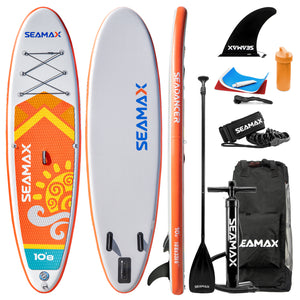

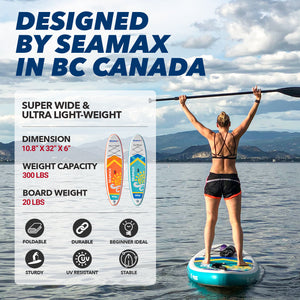

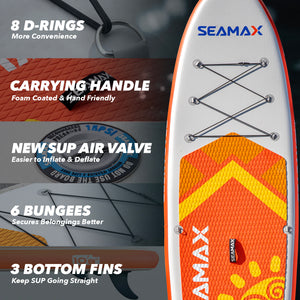
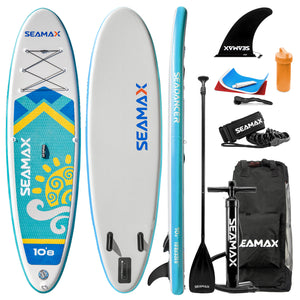
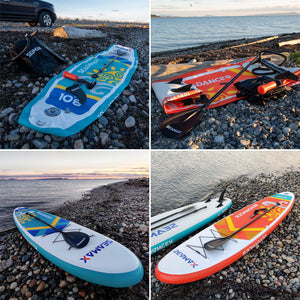
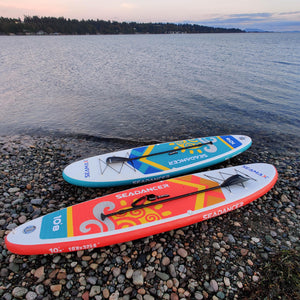
Seamax SeaDancer 108 Inflatable SUP Package, Dimensions L10'8ft x W32" x T6", 2 Color Available. Blue or Orange
252.00 USD
Most Popular board size L 10.8 ft x W 32”x H 6”; Customize single-ply fabric to build, 22Lbs light weight easy to carry, max support a 300Lbs person. Idea for saltwater and freshwater recreational use. Package includes telescope SUP paddle, Hand Pump with air gauge, Leash, Backpack style carrying bag, and repair kit.
FEATURES
Easy to Setup - Pull your SUP out of its bag and un-fold it. Take the Fin and hook them into place making sure that the longer portion is going towards the end of the board. Once the Fins are in place, turn the board over so that the valve at the front of the board is facing up. The net weight of Seamax 10.8ft SUP is about 22bs, and all included when in the backpack is about 28Lbs
Inflation - Remove the cap from the valve and check to see if the stem in the center of the valve is up (sticking up out of the valve) or down (even with the inner rim of the valve). The stem of this valve must be in the up (inflate) position to inflate the SUP until 15PSI. FYI, all Seamax SUP is 20 PSI tested.
Deflation - To deflate and break down your SUP, just remove the valve cap and push in the valve stem turning it clockwise a quarter turn to lock it in the deflate position. Un-hook the Fins by pressing the Fin holders to close together and popping the Fins off. Roll the SUP up with the top side facing out (this will push out all of the air), and put it away in its bag
Care & Guarantee - To clean your SUP, just use a mild detergent and warm water. You should rinse your SUP off with fresh water after using it in saltwater. To ensure that your SUP lasts for years to come, do not store it in direct sunlight uncovered or in extremely hot or cold temperatures for long periods of time. Seamax Canada 1 year fully guarantee, plus 2 years for Seam air leaking issue.
ADDITIONAL INFO
Paddling Knowledge
1. Make sure that your SUP is fully inflated. It should be nearly rock hard and when standing on the SUP in the water and it should not bend. Your paddleboard may flex some with your weight, but it should not bend to the point of creating a crease.
2. If you are paddling in open water, such as a lake or the ocean, make sure that you use an ankle leash. If you are fall off, your board could be swept away from you, leaving you stranded. An ankle leash will keep this from happening.
3. If you are paddling a river, do not use an ankle leash. This could be very dangerous because if you fall off, your board could pull you under the water as it continues down the river. Also, an ankle leash could get caught on items under the water and pull you off of your board as you are riding down the river.4. Be careful in windy conditions. Because you are completely above the water, strong winds can greatly affect you and could push you around.
5. Never leave your board, even if you lose your paddle. You can still paddle your board with your hands, which is easier than trying to swim back to shore. Also, if the wind was to pick up, your board will blow away from you faster than you can swim to it. This is why an ankle leash is so important.
6. Foot Position: You should stand in the middle of the board when paddling. When on flat water, stand with your feet about shoulder-width apart and face forward. If you are surfing or in choppy water, you want to take more of a surfer’s stance with your dominant foot facing forward. Your feet are not glued to the board, make sure to get used to moving your feet around on the board because the sooner that you do this the more comfortable you will feel about doing turns and riding waves.
7. The Best way to turn your board is to stand with your foot at the tail of the board with your weight over the fins. This is where foot movement will come in handy
Quick Instruction of using Dual Action Hand Pump - You should connect the Dual Action switch plug when first start. So you can work fast. You want to unplug the Double Action plug when pressure reach 5-8 PSI. So you can be easier for continued pumping. You may only want to check the air gauge when 10 PSI reached.
Many customers are the first time to use the hand pump with SUP. the spring-load type air gauge is built-in on the pump. Since the air gauge is very small, so it won’t be very sensitive especially when measuring low pressure. The air gauge best working range is 10-20 PSI for SUP purpose. When it working, the air pressure from SUP will need to be transferred via the long hose. You may start to see the air gauge moving when 2-3 PSI reached. This is normal.
If you stop pumping air too early, you won’t be able to see the air gauge moving. And since you worry about over-inflate the SUP and void the warranty. You may be worry about the air gauge. Actually our SUP is all 20 PSI tested and rated at 15 PSI. There is no record that only using our hand pump can blow out our SUP.
We want to give you some more information here and guide you how to qualify the air pressure in the SUP. First understand that the pump output pressure will be equal to the pressure in the SUP chamber. Your pushing down power will relate to the pump pressure output.
Pump output pressure can reach 3 PSI when hand pump receives 20 Lbs Push Power, SUP may feel soft when pressing by finger.Pump output pressure can reach 6 PSI when hand pump receives 40 Lbs Push Power, SUP will feel hard when pressing by handPump output pressure can reach 12 PSI when hand pump receives 80 Lbs Push Power. SUP very solid and support a body weight without bendingPump output pressure can reach 15 PSI when hand pump receives 100 Lbs Push Power, SUP good for max loading and with sporting performance.
Beginner-Friendly
Our SeaDancer SUP is a boon for beginners. As it has the functions of riding, sitting, and standing simultaneously, beginners can quickly learn how to balance on the inflatable paddleboard. With a size of 10'8"x33", you can ride on it easily, ensuring stability while you learn how to balance on the board.
Light & Portable
Crafted with Super-Reinforced
Drop Stitch Fabric for super wide &
ultra light-weight, board weight is 20 LBS. You can effortlessly bring our board on your travels and trips.
3 Bottom Fins
Our board features three bottom fins – two fixed small fins and a central fin to make your journey more stable. It is much easier to control the direction with three fins working together. Our central removable fin is tightly screw-fixed, keeping it in place throughout your adventures.

























